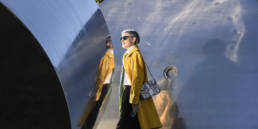There’s an exhibition on now called “Pontormo e il suo seguito nelle terre d’Empoli” – no English translation of the title, since no English information is available. I thought it looked very appealing, and decided to dedicate my Sunday afternoon to visiting it. Organized by the Città degli Uffizi, which loans works from the important museum to minor centers, I had received excellent press information with photos of works by Pontormo, Bronzino, Jacopo da Empoli and a few derivative Mannerist artists. It’d be easy just to publish the press photos and say something neutral, but I can’t do it. Pontormo in Empoli is one of the worst exhibits I have seen in recent years. Shows like this are the reason that nobody bothers going to see art exhibitions in Italy, and the crappy turn-out then spirals into a lack of funding for future, potentially decent, shows.

“Pontormo in Empoli,” as we shall call it in English, had the potential to be pretty good. First of all, because it is organized by the Città degli Uffizi and includes the important name of Pontormo, it managed to get both large and small sponsors. The Ente Cassa di Risparmio is the main sponsor, as well as some local utilities, a four star hotel, the Coop, Sammontana gelato, and some other small companies. The pamphlet has so many logos on it, it takes up one of eight pages. With this money, they were able to create a nice display and graphic material, and there’s even a dedicated Facebook page.

It’s a small exhibition, with only thirteen works, of which 2 are drawings, and four are in their permanent location. But volume is not necessary for an exhibit that intends to communicate the influence of an artist of this import on the territory in which he was born. For Jacopo Carucci was born in Pontorme, a little “frazione” or hamlet now engulfed by the larger town of Empoli, in 1494. An orphan, he was sent to train in a Florentine bottega at age 13, so he didn’t train or work here in Pontorme or in Empoli. He did paint an altarpiece for his hometown, of which remains two standing saints around an empty lunette, still conserved in the church of San Michele. So, it would be fascinating to know the context within which this painting was produced: its patrons, how they lured him back to the town from the big city, the importance of the saints here, and more.

The works that accompany this altarpiece and two drawings by Pontormo are intended to, in the words of curator Cristina Gelli, “dar conto dell’eredità del magistero di Jacopo Carucci su alcuni artisti la cui attività trova espressione nel territorio empolese” (sum up the influence of the greatness* of Jacopo Carucci on some artists whose body of work finds its expression in the Empolese [magistero may also mean “teaching”, this is unclear]). Basing the whole exhibit on a totally vague and not entirely unequivocal statement may be the problem. I don’t know what contact Pontormo had with these artists, how much time he spent on Empolese territory, and specifically in what way he influenced these specific artists. No wall text in the exhibit explains this, nor does the attractive pamphlet or the information published online. I also have access to a biography and press release that are not available elsewhere online, and these essential points are simply not addressed.

Pontormo in Empoli thus follows in the tracks of numerous exhibitions in Italy that trace the “fortuna” or “eredità” of an artist, attempting to sell entrance tickets with a big name, and putting one work by that artists amongst a few dozen others, where there may be at best a whiff of the named artists’s style (and that style should be interpreted by the viewer, who should be knowledgeable enough to recognize it.)
The Italian public, however, is no longer fooled. Antonio Natali, director of the Polo Museale Fiorentino, reports to the Empoli edition of La Nazione newspaper (source) his disappointment with the entrance numbers: 1600 visitors in the first 6 weeks of the show’s life. The area around Empoli counts about 150,000 people, and shows like this are designed to engage the locals, but the Empolesi themselves are not going to see it. (There are even a few potentially interesting conferences around the show, which ought to draw visitors.) Of the few visitors that were present on this balmy Sunday afternoon that I sacrificed in the name of art, we were the only ones able to walk without the assistance of a cane or walker. A show like this costs from 140,000 to 200,000 euros, and to be anything other than a total failure, Natali says they need to see at least 10,000 visitors. Or else? Or else the sponsors will go running away with their tail between their legs and never donate another euro to the arts.
The problem is that nobody wants to support the arts because Italian exhibitions seem to be made by Italian art historians, for other Italian art historians. For there seems to be an assumption that a visitor should already be familiar with the artist’s biography, the subject matter represented, and especially with visual analysis in order to draw his or her own conclusions about relationships of style, based on historical information stored in his or her own head. God forbid there should be an introductory video, an audioguide (I hate audioguides, but maybe this would be useful), a 5 minute guided visit by a student, a biography of the artist printed on a panel, an app, a diagram of relationships between people, or any other information beyond a 50 word label in order to communicate the basic information necessary to understand the point of the exhibition.

Pontormo is one of the most interesting characters of the late Italian Renaissance. He survived almost entirely on boiled eggs [correction – an expert friend says they were omlettes], after all, and painted scenes with such elongated figures that you wonder what hallucinatory drugs he was on. Today I was in the house in which he was born, I visited his natal town, I saw a work of his in situ, and it left me feeling BLEH. This is a shame that could have been avoided by the use of simple and inexpensive communication methods that should come naturally to any didactic-minded curator. The failure of this exhibit will cause the few sponsors who still have a lira to spare to reconsider giving money next time, causing the crisis of the arts in Italy to fall further down into its own, deep hole.
Update: a response from Antonio Natali
The local online news website GoNews.it read this review and deemed it worthy of sharing by writing an article entitled “Una esperta d’arte canadese stronca la mostra del Pontormo” (Canadian art expert kills the Pontormo exhibit). As this generated much discussion, the newspaper’s director, Giacomo Cioni, then took the trouble to phone Antonio Natali and ask him what he thought, resulting in the article “Antonio Natali sul Pontormo: “Una mostra per la gente di Empoli, con un catalogo snello e accessibile. Venite a vedere””. A full translation of his refutation is as follows:
“Natali confirms (the data cited about visitor numbers) and takes the trouble of also commenting and answering the points made by the art critic Alexandra Korey, although he does not know who she is. One can say and do anything ‘on the net’. To the opinion of the signorina [young unmarried woman without academic qualifications] I wish to contrast that of Mina Gregori, who has been to the exhibition in December and was enthusiastic. Let me add that from a didactic point of view we tried to keep the price of the catalogue low.
Beside every work is a label and a brief explanation. I seem to have understood that the spirit of the exhibit was to do a census of those who derived certain influences from Pontormo and that this goal has been fully reached. Concrete relations with Pontormo? What is the signorina talking about? Well, with regards to il Cigoli his contemporaries talked about him, Naldini is an artist who departs from Pontormo, Macchietti and (Jacopo di) Empoli idem. They are all connected to this area. The exhibit organized by the Comunune di Empoli is an exhibit, as many other local ones, that tries to improve the historical awareness of its citizens. And I am speaking to them when I say that this may be the occasion to go and see it in person and see if what this young lady says is the truth of the matter.”
I would also say that the City of Empoli’s effort in [organizing this] exhibit is appreciable. So it seems to me that the wall text is exhaustive and that the catalogue is intentionally inexpensive, and the young art historians of Empoli have done a good job going through all the local churches for their research. It is not fair to criticize this exhibit.”
With thanks to GoNews for raising the question, it is clear that Dr. Natali and I are unlikely to see eye to eye on the matter, and I am pleased that he took the time to read and refute my points. Putting the derogatory references to signorina aside, if I were just a signorina and not dottoressa (the title used for people with a university degree) it would be even more important to listen to my opinion. For the signorina would represent the general public to whom the exhibit is targeted, who may not have had the advantage of 13 years of university art history study as I have. The fact is that the audience is changing, everywhere in Italy and in particular in Empoli. Empoli is a vibrant and young city that has attracted many young couples and new families due to its attractive property prices. Busy, young people who are used to modern communications, who have limited time for the arts and treat the arts as a fun activity to experience with family and friends. We can no longer depend on the contextual knowledge gained by growing up in a place and receiving the rigorous education once provided by the Italian school system, nor can we expect that people will be reading the catalogue (although making it available for consultation inside the exhibition space would be a wonderful help for those wishing to dig deeper). Even when viewers are highly educated, viewers now expect certain things to be spelled out for them, and there is nothing debasing or unscholarly about doing this. Dr. Natali has kindly backed up my point by mentioning the appreciation that Dr. Gregori has of the show: made by Italian art historians, for Italian art historians. I have heard Dr. Natali speak many times, and am always impressed by the fascinating information he imparts and at his depth of knowlege; I also have the maximum respect for Dr. Gregori, a groundbreaking professor. I wish that many more people could benefit from this knowledge.
I wish to point out that I also visited the MuVe, a museum dedicated to glass, and found that it does an impressive job communicating the close relation of production and the Empolese territory in a contemporary manner (I plan to publish a review soon). This review has also resulted in an invitation from a local historian to get to know the city and its art better, which I will take up. I hope that the discussion stirred up can be taken as more than just polemical but a frank raising of a real problem that would not take much to resolve.
Exhibition information (for self-flagellants)
Pontormo e il suo seguito nelle Terre D’Empoli
Pontorme (Empoli)
November 29 2013 to March 2, 2014
Sign up to receive future blog posts by email
Alexandra Korey
Alexandra Korey aka @arttrav on social media, is a Florence-based writer and digital consultant. Her blog, ArtTrav has been online since 2004.
Related Posts
November 17, 2021
My favourite suppliers of Tuscan olive oil
May 20, 2021
Volterra: Art, Wine and Minerals
January 17, 2021




